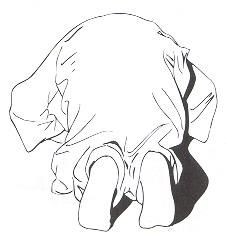The Prophet (may the peace and blessings of Allah be upon him) used to place his nose, and forehead firmly on the ground in prostration. He would also keep his arms away from his sides, and he would put both his palms in line with his shoulders (on the ground). 
Abū Ḥumayd as-Sā'idī (may Allah be pleased with him) narrated:
"...The Prophet (may the peace and blessings of Allah be upon him) then prostrated, and placed his nose and forehead (on the ground); and kept his arms away from his sides, and placed his palms on the ground in line with his shoulders..." [Abū Dāwood: 734]
His knees and feet would be firmly placed on the ground, as was narrated from Ibn 'Abbās (may Allah be pleased with him), that the Prophet (may the peace and blessings of Allah be upon him) said:
"I have been commanded to prostrate on seven bones: on the forehead - pointing with his hand to the nose [at the same time] - the hands, the knees and the tips of the feet." [an-Nasā'ī: 1097]
'Aa'ishah (may Allah be pleased with her) narrated:
"...my hand touched both his feet while they were held upright, and he was prostrating." [Muslim: 486]
From the above hadith, the scholars have deduced that the feet should be next to each other, as how would the hand of 'Aa'ishah (may Allah be pleased with her) have touched both of the feet of the Messenger (may the peace and blessings of Allah be upon him) while he was prostrating, unless his feet were next to each other.
Also, it is from the guidance of the Prophet (May the peace and blessings of Allah be upon him) to not spread the arms nor contract them while on the ground, as narrated by Abū Ḥumayd as-Sā'idī (may Allah be pleased with him) that the Prophet (may the peace and blessings of Allah be upon him):
"In prostration, used to put his hands (on the ground), and he would neither spread [his arms] nor contract them..." [al-Bukhārī: ???]
The extent to which the Prophet (may the peace and blessings of Allah be upon him) used to spread his arms while in a state of prostration is mentioned in the following hadith narrated by 'Abdullāh ibn Buḥainah (may Allah be pleased with him):
"The Prophet (may the peace and blessings of Allah be upon him) spread his arms so much that the whiteness of his armpits became visible." [al-Bukhārī: 390; Muslim: 495]
Maymoonah (may Allah be pleased with her) narrated that:
"The Prophet (may the peace and blessings of Allah be upon him) would prostrate in such a way that if a baby-goat wanted to pass under his arms, it could easily do so." [Muslim: 496]
The meaning of the above narrations, is that the Prophet (may the peace and blessings of Allah be upon him) used to keep his chest and stomach up high from the ground. The ruling for women is also the same as there are no narrations that single the women out with a certain way of praying.
Also, its recommended to to make the tips of the toes point to the Qiblah while prostrating, as narrated:
"..and his toes would face the Qiblah." [al-Bukhārī: 828]
The Prophet Muhammad (may the peace and blessings of Allah be upon him) also discouraged prostrating in a way that resembles a dog, with the forearms laid flat along the ground, as in this narration:
"Be moderate in sujood, and none of you should lay his forearms (on the ground) as a dog lays them (i.e resting the elbow and the forearm flat on the ground)" [al-Bukhārī: 822, Muslim: 493]